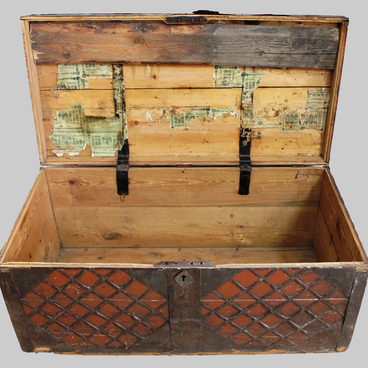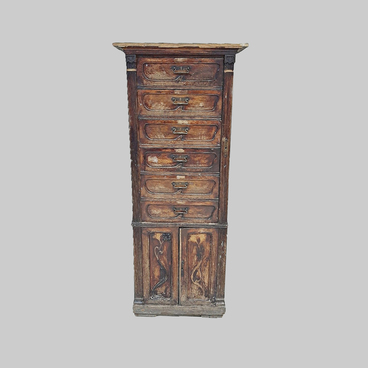Old spring scales ‘Kantarik’ from the museum’s collections are made in the form of an iron ring with two hooks for hanging cargo and two rings. This type of spring scales has a rather original design. The role of a measuring spring is performed by a rigid ring, within which a scale in the form of a crescent is installed. These household scales have a ring of the most common type. Its length is about 10 centimeters. However, there are exceptions. For example, private collections feature giant kantars with the length of the ring of 28 centimeters. The weighing limit for large models could reach 400 kilograms.
Spring scales in the shape of an iron ring with one or two cargo hooks were known by various names. In English-speaking countries, they were called “hidescale”, “Germanсrab”, and “Gypsyscale”. The Germans named them “Jagdwaage”, i.e. “hunter scales”, and “Mondwaage”, which means “moon scales”. Similar associations were found in the French where this type of spring scales was known as “demi-lune”, which means “crescent”. In Russia, there was also no single term for these scales. Such words as “kantar”, “kontar”, “kantarik”, “pudovik” (one-pood weight) and “bezmen” (spring scales) were used depending on the region.
As a rule, kantariks were wade in England and Germany, presumably, in the period from the 17th century to the Second World War. Kantariks of the Russian weight system were produced and supplied to Russia and Poland before the First World War. They are still found in considerable numbers, which indicates a fairly wide distribution of spring scales. The “PUD” and/or “RS” markings were common on the kantariks of the Russian system.
Such spring scales were widely used in agriculture for weighing meat and hay, in everyday life as kitchen scales, and in hunting to determine the weight of prey. The production of spring scales of this type began to decline at the turn of the 20th century.
Despite the rather long period of their existence, these unusual scales are very poorly studied. In particular, there is still no information about many manufacturers of moon scales, many of the kantariks are difficult to date, and it is not clear whether there is a connection between the weighing limit and the time of manufacture of these spring scales.
Spring scales in the shape of an iron ring with one or two cargo hooks were known by various names. In English-speaking countries, they were called “hidescale”, “Germanсrab”, and “Gypsyscale”. The Germans named them “Jagdwaage”, i.e. “hunter scales”, and “Mondwaage”, which means “moon scales”. Similar associations were found in the French where this type of spring scales was known as “demi-lune”, which means “crescent”. In Russia, there was also no single term for these scales. Such words as “kantar”, “kontar”, “kantarik”, “pudovik” (one-pood weight) and “bezmen” (spring scales) were used depending on the region.
As a rule, kantariks were wade in England and Germany, presumably, in the period from the 17th century to the Second World War. Kantariks of the Russian weight system were produced and supplied to Russia and Poland before the First World War. They are still found in considerable numbers, which indicates a fairly wide distribution of spring scales. The “PUD” and/or “RS” markings were common on the kantariks of the Russian system.
Such spring scales were widely used in agriculture for weighing meat and hay, in everyday life as kitchen scales, and in hunting to determine the weight of prey. The production of spring scales of this type began to decline at the turn of the 20th century.
Despite the rather long period of their existence, these unusual scales are very poorly studied. In particular, there is still no information about many manufacturers of moon scales, many of the kantariks are difficult to date, and it is not clear whether there is a connection between the weighing limit and the time of manufacture of these spring scales.



